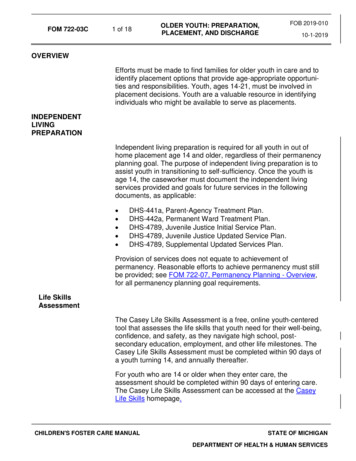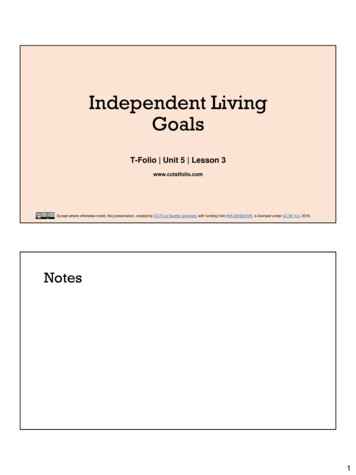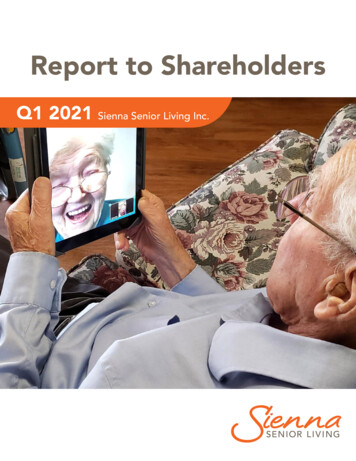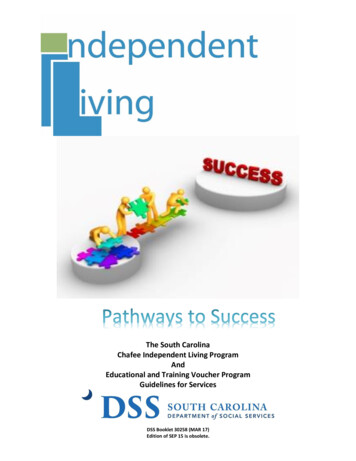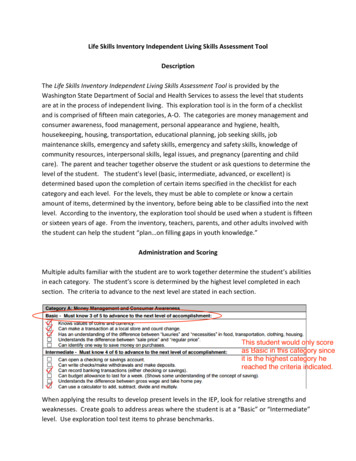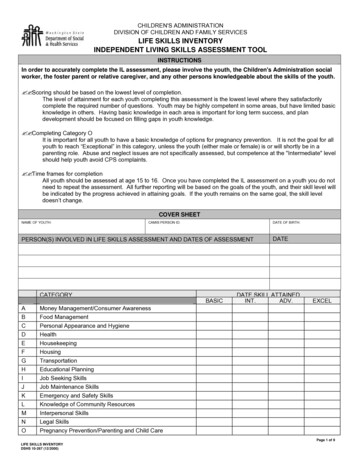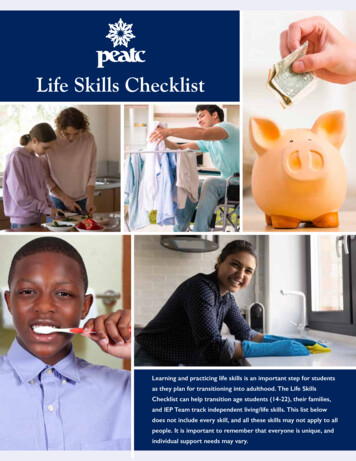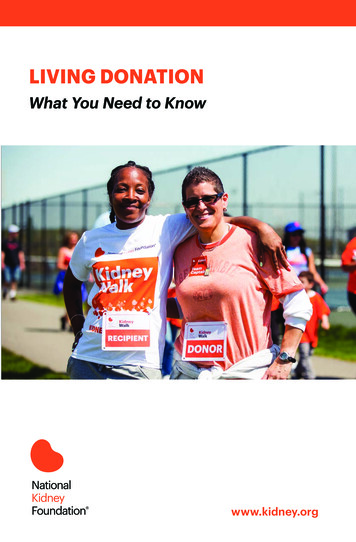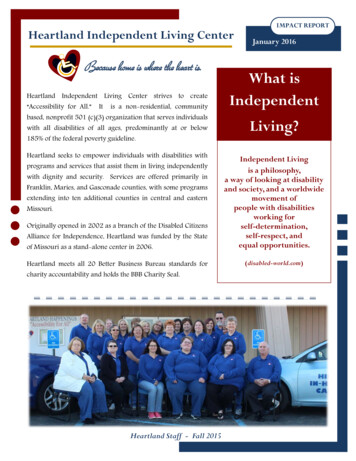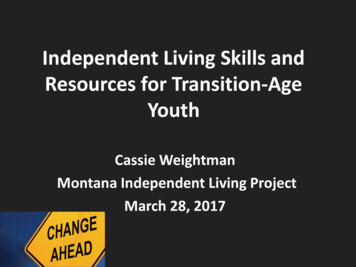
Transcription
Independent Living Skills andResources for Transition-AgeYouthCassie WeightmanMontana Independent Living ProjectMarch 28, 2017
Overview Centers for Independent Living (CILS) Services Offered through CILS Youth Transition and CILS*Please feel free to ask questions as we go2
Centers for Independent LivingThe term "center for independent living" means aconsumer-controlled, community-based, cross-disability,nonresidential private nonprofit agency that is designed andoperated within a local community by individuals withdisabilities and provides an array of independent livingservices.3
Benefit of Centers forIndependent LivingWe’re all over the United ter-and-association-directory4
The Philosophy of Independent LivingMT Centers for Independent Living believe in theIndependent Living Philosophy as a basic foundation fromwhich we provide both consumer and communityservices.Independent living is based on the value that people withdisabilities have the right to control their own lives andthat disability is a natural part of the human experience.5
IL Philosophy (continued)Key elements of this philosophy are: Consumer control – We believe that the consumer should settheir own goals and take the lead in achieving them Self-help and self-advocacy –We believe the importance ofeducating ourselves, asserting our rights and taking action onour own behalf. Peer support – We believe we can learn from and support oneanother through the bond of shared experience.6
IL Philosophy (continued) Inclusion – We believe each person has unique ideas, talents andcontributions which are to be valued. We believe in equal accessand participation for all. Cross-disability –We recognize the importance of including ALLpeople, regardless of disability. Diverse cultural background – We recognize that disabilitytranscends race, gender, ethnicity, religion, economics and sexualorientation. Social change – We focus on changing society vs. “fixing” theindividual. This movement, is at its core, one of human and civil7rights.
IL Philosophy (continued) Leadership development- We instill in each other the skills andconfidence needed to grow as leaders and assume leadershiproles within the independent living movement and society atlarge. Rights and responsibilities –We believe that personal powerand independence come not only from the free exercise ofhuman and civil rights but also from assuming responsibility forour needs and owning the consequences of our actions.8
CIL Core ServicesThere are 5 Core Services that CILs are requiredto provide.9
Information & Referral Centers provide information and referral for personswith disabilities seeking to meet such needs asaffordable & accessible housing, energy assistance,Americans with Disabilities Act information, assistivedevices/equipment, employment and transportation. Centers also assist consumers in navigating the processof applying for such government benefits as FoodStamps, Social Security, Medicare and Medicaid.10
Self-AdvocacyCILs are committed to helping consumers takeresponsibility and become active participants in their ownlives! Centers assist consumers in developing the skillsnecessary to advocate for themselves and their needs. Needs can include: housing, education, health care,benefits, income, employment, accommodation,disclosure and social acceptance.11
Peer SupportCILs are committed to creating a mutually supportivenetwork among persons with disabilities in our serviceareas. Peers are individuals living successfully with theirdisabilities who have indicated a willingness to sharetheir experience in order to educate others. Peer Support can include one-on-one as well as smalland even large group interactions.12
Skills TrainingCILs provide services to persons with disabilities to help themgain the skills they need to succeed in an independent livingsituation. Skills are taught either on an individual basis or in a groupsetting. Classes vary between centers and can include“Living Well With a Disability”, Soft Skills Training, HealthyRelationships, Self-Determination and others. Skills taught can range from learning to apply for SocialSecurity, budgeting, discovering how to acquire a piece ofequipment through Medicaid, to learning to discuss theirdisability with employers and many more.13
Community ServicesBeyond providing resources for individual empowerment, CILsalso work to promote acceptance and inclusion of personswith disabilities in the wider community.Services fall under two categories: Social Action Systems Change14
Social ActionCILs promote inclusion, opportunity and diversity for peoplewith disabilities locally, statewide, nationally and worldwide.Centers advocate and partner with schools, businesses andcommunity organizations.15
Social Action (continued)Centers educate on a variety of issues such as: Creating an environment for persons withdisabilities that is more accessible in its Physical or design features Program and organizational policies Public attitude of acceptance16
Systems Change CILs work in a non-partisan manner with government at alllevels to educate officials on the realities of life for personswith disabilities. Centers help to design and advocate for legislation andpolicies that produce a framework within which persons withdisabilities can achieve self-determination. Centers also work to assure that once such legislation andpolicies are in place, they are properly enforced andadministered.17
Systems Change (continued)Other examples of systems change include: Attend conferences or symposiums Participate on task forces or committees Write letters to the editor, editorials and being available todiscuss issues with media members Testify at hearings or other public meetings Send out and respond to Action Alerts Follow up with disability rights legislation18
Self-Directed Personal Care Assistance*Not available at all centers*Self-Directed Personal Care Assistance allows Montanans withdisabilities who qualify under Medicaid guidelines, or theirrepresentative, to hire, train and supervise the personalassistants working in their homes, allowing them to stay intheir own homes and communities.19
Transition ServicesMontana Centers for IL offer guidance to persons with disabilitiesas they move through each stage of life; examples of transitionservices offered by centers include: Helping persons under the threat of institutionalization stay intheir homes and communities (nursing home diversion). Helping institutionalized persons return to their homes andcommunities (nursing home transition). Helping youth with disabilities move from K-12 education topost-secondary education and the working world, andindependent living.20
Youth Transition Montana CILs are working within the state and nationally to stay up onYouth Transitions ideas and approaches. APRIL Youth NCIL Youth Montana Youth Transitions Regional Transition Groups MYLF Local Youth Activities Youth in Motion YODA BASE21
Youth Transition Youth Transitions begin as soon as a disability isidentified.22
23
How can CILs help?One-stop shop for: Answering questions (any questions you may have, we’ll try to helpfind the answers) Getting help to navigate the different systems Attend meetings (e.g., IEP, VR, SSA) Help with paperwork Connect students with social opportunities Help students find their voice through group and individual learning(i.e., Self-Advocacy, Self-Determination)24
How can CILs help? (continued) Skills training (e.g., learning to ride the bus, cook,budget, soft skills) Understanding how working impacts SSA benefitsand how to report wages Finding volunteer opportunities in the community ADVOCACY (sometimes you need a second set ofears and voice to get the right answers) If you have an idea, contact your local center to seehow we can partner together and help25
Major Questions CILS HearAbout Transitions Can my child . Work Live on their own Guardianships Alternatives to Guardianships Power of Attorney (durable, medical) Limited Guardianships Payee26
Who should contact CILS? Teachers IEP Advocacy Questions about adaptive technology Helping families navigate the transition process Partner for Pre-Employment Transition Services (VR) tooffer self-determination education, Life Skills education,employment, etc.27
Who should contact CILS? (continued) Service Providers (Job Services, Vocational Rehabilitation,Case Managers, etc.) May help with a variety of things Serve as an advocate Assist with paperwork Walk through the steps to reach a goal Help answer questions about the Americans with DisabilitiesAct Connect individuals with social connections And much more .tailored to the individual’s needs28
Who should contact CILS? (continued) Youth Learn about what youth programs your local center offers Assist you with goals of employment, living on your own,other goals you want to work on independently Invite us to your IEP to serve as an advocate29
Who should contact CILS? (continued) Parents/Family Members Learn about what youth programs are available Have center staff help you navigate the various systems andfind out what adult services are important for your student Engage center staff with your student to build independence(sometimes we learn better when it’s not our parent) Understanding how to help your student be independent whilenot taking away their independence Paperwork! (SSA, SNAP, Medicaid, etc.) Anyone! If you have any questions related to disability, callus. If we don't know we’ll do our best to figure it out.30
QuestionsCassie Weightmancweightman@milp.us(406) 782-4834Montana Independent Living Project3475 Monroe, Suite 100Butte, MT 5970131
This project is funded in whole or in part under acontract with the Montana Department of PublicHealth and Human Services. The statementsherein do not necessarily reflect the opinion ofthe Department.University of Montana Rural Institute for Inclusive CommunitiesMarch 2017
Helping youth with disabilities move from K-12 education to post-secondary education and the working world, and independent living. 20. Youth Transition Montana CILs are working within the state and nationally to stay up on Youth Transitions ideas and approaches. APRIL Youth
